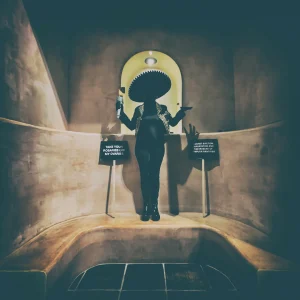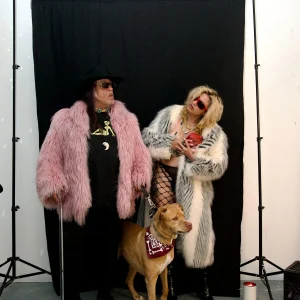Guillermo Gómez-Peña is a performance artist, writer, activist, radical pedagogue and artistic director of the performance troupe La Pocha Nostra. Born in Mexico City, he moved to the US in 1978, and since 1995, his three homes have been San Francisco, Mexico City and the "road". His performance work and 21 books have contributed to the debates on cultural, generational, and gender diversity, border culture and North-South relations. His artwork has been presented at over one thousand venues across the US, Canada, Latin America, Europe, Russia, South Africa and Australia. A MacArthur Fellow, USA Artists Fellow, and a Bessie, Guggenheim, and American Book Award recipient, he is a regular contributor to newspapers and magazines in the US, Mexico, and Europe and a contributing editor to The Drama Review (NYU-MIT), the Venice International Performance Art Week book series, and emisférica, the publication of the Hemispheric Institute of Performance and Politics (NYU). Gómez-Peña is currently a Patron for the London-based Live Art Development Agency and a Senior Fellow in the Hemispheric Institute of Performance and Politics. Since March 2020, Gómez-Peña and La Pocha Nostra have adopted a hybrid practice where virtuality and media (film, radio, sound art, photo-performance, online performance & pedagogy) provide ways to continue creating work and reaching trans-national “live” audiences and communities of difference. LPN has never stopped creating and presenting performances, continually pushing the boundaries of how to adapt performance, installation, spoken word and “living archives” (a cosmology of iconic materials, props, costumes, original photo, video, print materials & ephemera engaged with performatively) to newly enhanced virtual formats and the artistic and philosophical challenges posed by confinement.
Balitrónica is a cyborg-feminist poet, performance artist, hereditary witch, 2nd Degree Cabot Priestess, and co-Artistic director of La Pocha Nostra. Since joining La Pocha Nostra, she has made a full-time performance practice that explores the ideas of ritual psycho-magic acts, occult methods of transcendence, and the human body as a conduit for clairvoyant mediumship. In addition to her formal training in musical theatre and Victorian literature, she holds an MFA in Poetry & Creative Writing from Mills College. Her performance work has been largely influenced by her time living in a 17th-century Catholic Convent in Paris with a Dominican Order of Nuns. Balitrónica has been touring internationally with Gómez-Peña since 2013 and currently resides between San Francisco, Mexico City, and the San Diego/Tijuana Border.
Founded in 1993 in Los Angeles, La Pocha Nostra is Gómez-Peña’s ultimate and most long-standing project. La Pocha Nostra is a transdisciplinary arts organization & 501-c3 non-profit that provides a support network and forum for artists of various disciplines, generations, gender complexities and ethnic backgrounds. La Pocha is devoted to erasing the borders between art and politics, art practice and theory, artist and spectator. For 25+ years, LPN has intensely focused on the notion of collaboration across national borders, race, gender and generations as an act of radical citizen diplomacy and as a means to create “ephemeral communities” of rebel artists. La Pocha Nostra’s performance work mixes experimental aesthetics, activist politics, Spanglish humour and audience participation to create a "total experience" for both live and online audience members/readers/viewers. Continually developing multi-centric narratives and large-scale performance projects from a border perspective, La Pocha Nostra creates what critics have termed "Chicano cyber-punk performances," and "ethno-techno art." In the work, cultural borders have moved to the centre. At the same time, the alleged mainstream is pushed to the margins and treated as exotic and unfamiliar, placing the audience members and readers in the position of "foreigners" or "minorities." La Pocha Nostra’s artwork has been presented at over a thousand venues across the US, Canada, Mexico, Spain, the UK, Germany, Haiti, Latvia, Belgium, Greece, Switzerland, Italy, Sweden, Norway, Finland, Poland, Russia, Australia, South Africa, Colombia, Puerto Rico, Cuba, Brazil, Peru, Venezuela and Argentina. La Pocha Nostra has participated in the following Biennales: Venice, Documenta, Havana, The Whitney Museum, Sydney, Liverpool, Thessaloniki and Mercosur, and they performed at the Venice International Performance Art Week. The troupe’s photo performances are now in the permanent collections of the Daros Foundation (Zurich), Galeria Artificios (Gran Canaria), the MAM (Mexico City), and the Getty (Los Angeles), among other institutions.
Collaborating Film Makers for Alien Planet 2.22:
EmaLee Arroyo is a Chicana Abolitionist artist from the "geographic" southwest of North America, Albuquerque, the 505, NUEVO México. The land of The Sandia Pueblo, the land of the Tiwa languages. The colonized outpost. EmaLee specializes in filmmaking, editing, and performance art. EmaLee's works center on the lived experience of a FEMME CHICANA BODY in the post-apocalypse of the PANDEMIA and predicted the Mayan end of the world. From music videos, fashion films, commercials and documentaries to avant-garde performance art films, EmaLee's work is inspired by the works of La Pocha Nostra & and the awe-inspiring ways humans live in communities around the world. Her award-winning documentary, "Miss Snake Charmer" is streaming on several platforms and much of her work has been shown internationally. She has been collaborating with La Pocha Nostra since 2009.
Sarah Stolar is an interdisciplinary artist whose work includes painting, drawing, multimedia installation, film, video, and performance art. Rooted in a 25-year investigation of the female psychological narrative, common threads in her work include loss of innocence, sexuality, power, death, spirituality, and identity. She holds an MFA in New Genres from the San Francisco Art Institute and her work has been exhibited across the United States and internationally. She is an award-winning filmmaker and is currently the Chair of the Department of Fine Arts, Film and Digital Media at the University of New Mexico-Taos.





